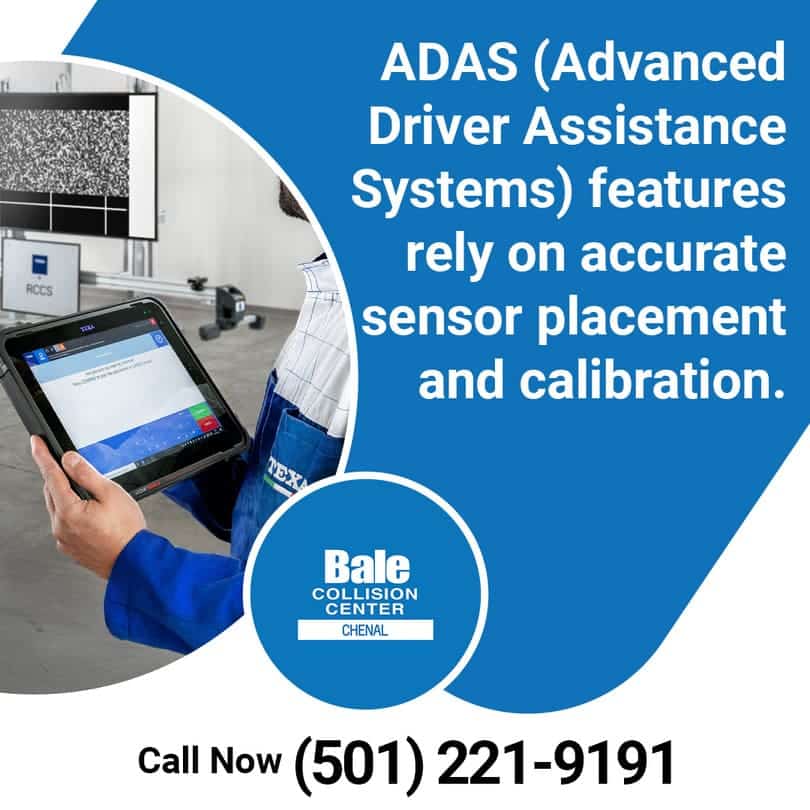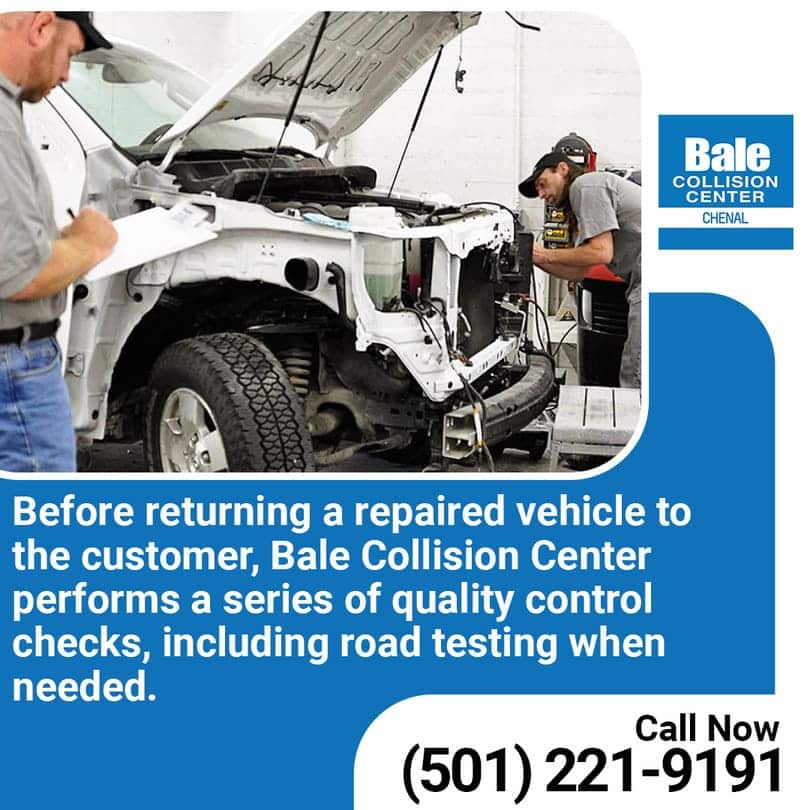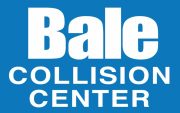Even a minor collision can interfere with the safety features built into your vehicle. Sensors, cameras, and structural components often shift or stop functioning correctly after an impact. Many of these are built into bumpers, grilles, mirrors, and windshields, which are areas commonly damaged in accidents. Improper repairs can cause these systems to fail when you need them most. That’s why auto collision repair today involves far more than just cosmetic fixes. Every step must account for what’s underneath the surface.
At Bale Collision Center (Chenal) in Little Rock, we follow strict repair guidelines to restore both your vehicle’s appearance and its original safety performance. From factory scan tools to ADAS calibration, we’re equipped to return your vehicle to road-ready condition. This article explains how collision damage affects safety features and how our process protects the systems you depend on every day.

The Connection Between Vehicle Safety and Collision Repair
Safety systems are designed to work in sync with your vehicle’s physical structure. Any structural damage or misalignment can interfere with how these systems function. At Bale Collision Center, we use manufacturer-approved tools and repair procedures to make sure all safety features are restored to their original performance.
How Safety Systems Interact With Vehicle Structure
Safety technology is mounted on and integrated with the structural parts of your car. If those structures are damaged or repaired incorrectly, the safety systems may not work at all.
For example, radar sensors for adaptive cruise control are usually mounted behind the front grille or bumper cover, side airbags rely on reinforced door frames and rocker panels to deploy at the right time, and cameras and sensors for blind spot monitoring and lane assistance are often calibrated to precise angles based on your vehicle’s geometry.
Even paint thickness can affect radar performance. This means that every aspect of a car collision repair, from pulling the frame to applying the final coat, can affect safety.
What Happens When Repairs Are Incomplete or Inaccurate
Improper repairs can stop safety systems from working altogether. Misplaced sensors, skipped calibrations, or unverified parts can leave drivers unprotected without warning.
A 2023 report from the Insurance Institute for Highway Safety (IIHS) found that about half of drivers who had repairs to crash avoidance systems later reported problems with ADAS features. These problems included false warnings, complete failures, or erratic performance.
At Bale Collision Center, all auto collision repair services include digital scanning before and after the work is complete. This identifies unseen faults and confirms that repairs haven’t compromised any electronic or structural system.
We also use OEM parts when required and recalibrate systems on-site using manufacturer-approved tools. This approach helps us restore the original safety performance of your vehicle.
How Impact Damage Affects Built-In Protection
Collision damage can weaken your vehicle’s safety structure, even if it looks minor. Parts like crumple zones and frame rails are designed to manage crash energy. If these are bent or misaligned, they may not protect passengers in future accidents.
At Bale Collision Center, every auto body and collision repair follows manufacturer guidelines. Our structural tools check for hidden misalignment and restore safety features to their original strength.
Misalignment and Its Consequences on Performance
Vehicle misalignment affects both safety and drivability after a collision. When the frame or suspension is even slightly off, the car may handle poorly, wear tires unevenly, or give false signals from safety sensors. These problems may go unnoticed until they lead to bigger issues.
For instance, a misaligned frame can cause the steering wheel to pull or vibrate. Sensors for systems like lane departure warning or automatic braking may also be thrown off by just a few degrees.
At Bale Collision Center, we take alignment seriously in every car collision repair. We use computerized frame straightening tools to return the structure to factory specifications.
How Structural Gaps Lead to Malfunctioning Components
Gaps between panels or shifts in structural alignment can interfere with critical vehicle functions. These gaps often appear around doors, bumpers, and hoods after a collision. While they may seem cosmetic, they can signal more serious underlying problems.
A common example is a misaligned bumper cover that blocks a front radar sensor. If the sensor can’t “see” the road ahead, systems like adaptive cruise control or forward collision warning may stop working. Similarly, if a door doesn’t seal correctly due to body misalignment, side airbags may not deploy in a side-impact crash.
Our auto body collision shop inspects for these gaps as part of our detailed collision repair process. We don’t rely on visual checks alone. We use digital measurement tools to make sure that every component is returned to its proper position. Before any vehicle is released, we also verify that sensors and electronics respond correctly to testing.
Restoring Factory Specifications After a Collision
Repairs that don’t match factory specifications can change how your vehicle responds in a crash. Each panel, weld, and bolt location plays a role in keeping you safe. That’s why exact collision repair procedures matter.
Why Precision Is Vital in Frame and Panel Repairs
A vehicle’s frame is designed to collapse in a controlled way during a crash. If a collision repair center doesn’t restore that structure precisely, crash forces may not spread as intended. For example, a frame rail repaired with the wrong gauge steel can either fold too easily or resist movement entirely. This can send energy into the cabin instead of away from it.
At Bale Collision Center, we use computerized frame measuring to compare the damaged structure to the original manufacturer’s data. This makes sure each section is realigned with precision.
The Role of Torque, Weld Points, and Fasteners
Every bolt and weld on a modern vehicle is placed and tightened to exact values for safety. These specs affect how the car handles stress, supports electronics, and holds panels together in a crash.
Too much torque can stretch bolts. Too little can cause movement between parts. Welds in the wrong spots can weaken adjacent metals, while missing fasteners can change how panels interact under force.
All repairs at our auto body collision shop follow manufacturer torque specs, welding procedures, and fastener layouts because these are safety-critical components of your car collision repair.
Impact on Restraint Systems and Airbag Deployment
Safety restraints and airbags are designed to work once and must be inspected or replaced after any collision. If they’re not reset or repaired properly, they may fail in a second crash.
Why Restraint Systems Must Be Replaced, Not Reused
Any restraint component that activates in a crash, like airbags or seatbelt pretensioners, must be replaced, not reused. These parts are single-use by design and cannot protect occupants again once triggered.
This includes not just the airbag unit itself but also the sensors, inflators, and crash modules tied to the system. In some cases, even seatbelt assemblies must be replaced due to internal locking mechanisms that cannot be reset. Reinstalling used or untested parts puts the driver and passengers at risk.
Bale Collision Center follows OEM procedures for every auto body and collision repair. That includes removing all affected restraint parts and replacing them with new, approved components from the vehicle’s manufacturer.
How Improper Diagnostics Affect Deployment Timing
Faulty diagnostics can delay or stop airbag deployment. Airbags are triggered by milliseconds of sensor data during a crash. If the sensors or modules are out of sync, they may misread the event or not respond at all.
Auto body collision shops that skip full-system diagnostics may miss stored crash codes or wiring problems caused by the collision. A failed or outdated control module might seem fine visually, but could prevent the entire system from responding properly.
At Bale Collision Center, we perform a full pre and post-repair scan on every vehicle. Our certified auto collision repair technicians reset, calibrate, and retest airbag systems using manufacturer guidelines. This step is essential in returning the vehicle to a safe operating condition after a collision.
Repairing Around Cameras, Sensors, and Radar Systems
Advanced driver assistance systems (ADAS) rely on cameras, radar, and ultrasonic sensors to support features like lane-keeping, adaptive cruise control, and emergency braking. Restoring their exact position during any auto collision repair is critical for reliable function.
Locations Most Commonly Overlooked
Front and rear bumper covers, windshield glass, and side mirror housings contain key sensors. A radar sensor behind a plastic bumper must sit at the right angle and distance to detect traffic properly. If the mount is even a few millimeters off, it may misread objects or fail to react. Similarly, windshield-mounted cameras for lane assist and auto-braking require recalibration anytime the glass is removed or shifted.
Bale Collision Center performs detailed inspections of these zones after auto body and collision repair. We follow OEM guidelines to locate, test, and reset affected systems, even if no dashboard warning is active.
Examples of Sensor Blindness After Incorrect Repairs
If sensors are not correctly repositioned or recalibrated, the vehicle may not see obstacles or may brake or steer without warning. These errors led to missed detections of other cars, incorrect lane warnings, and unexpected braking. Common causes included poorly aligned bumpers or replacement parts that were not designed for sensor use.
That’s why Bale Collision Center uses OEM-approved parts and calibration tools to repair all vehicles with ADAS. We confirm that the protective technology in your car performs as intended before you get back on the road.
Maintaining Proper Function in Traction, Steering, and Braking
Safety subsystems like traction control, power steering, and ABS rely on undamaged connections and calibrated sensors. Collision damage can interrupt these systems even without visible signs on the vehicle’s exterior.
How Collision Damage Affects Safety Subsystems
Even small frame shifts or wheel misalignment can confuse safety systems. A car that pulls to one side may have a misaligned steering angle sensor, which limits how the vehicle responds in a skid or turn.
For example, traction control uses data from all four wheels. If a sensor reads incorrect values due to damage, it may cut power or apply the wrong brake during cornering. Anti-lock brakes and stability control can also fail without warning if wiring or hydraulic lines are disturbed and not resecured properly.
Bale Collision Center checks wheel alignment, suspension geometry, and sensor connections as part of our car collision repair process. These steps prevent long-term control problems after a crash.
Rebuilding Electronic Stability and Anti-Lock Brake Connections
If the ABS or stability control wiring is damaged or corroded, the system may work intermittently or may stop working. These connections often run through wheel wells and underbody areas that are vulnerable during a collision.
For example, a rear-end impact can crush a harness that feeds the brake system module. Even if the brakes appear to work during normal driving, the electronic features may not engage under sudden pressure.
Our collision repair center uses OEM wiring diagrams and repair procedures to locate and restore every affected system. We test these components after every repair to confirm full functionality.
Calibrating ADAS to Manufacturer Guidelines
ADAS calibration must follow the specific measurements and procedures set by each vehicle’s manufacturer. These systems don’t work properly without precise alignment, even if the hardware is undamaged.
Advanced Driver Assistance Systems (ADAS) include tools like forward collision warning, lane departure alert, adaptive cruise control, and blind spot detection. Each feature depends on a camera or sensor mounted in a defined location on the vehicle.
Types of Systems That Require Calibration
Most modern vehicles include at least one ADAS feature that requires recalibration after body or structural repair. Forward-facing cameras, typically mounted behind the windshield, must be calibrated after glass replacement or front-end repair. Radar sensors in bumpers or grilles must be realigned anytime those panels are removed, shifted, or replaced. Blind spot monitors located in the rear quarter panels or mirrors also need recalibration after side damage.
All these systems require exact placement and scanning to work properly, especially after a crash. Our auto body collision shop performs both static and dynamic calibrations based on the system type and the manufacturer’s instructions.
How Missing a Calibration Can Create Risk on the Road
If a system is not calibrated, it may provide false warnings or fail to respond when it’s needed most. For example, a forward radar that’s off by just a few degrees might detect cars too late for the automatic brakes to engage. Such issues don’t always trigger a dashboard alert, which is why recalibration must be confirmed after any car collision repair.
Bale Collision Center checks for all ADAS-equipped features before and after repair. We document each calibration and verify that every sensor is reading correctly before the vehicle leaves our collision repair center.

What to Expect When You Bring Your Vehicle to Bale Collision Center
Our Intake Process and Initial Vehicle Inspection
When you visit Bale Collision Center, our intake process begins with an inspection that identifies all structural and safety-related damage. We perform a pre-repair scan using advanced diagnostic tools that connect directly with the vehicle’s onboard systems. This scan identifies any stored fault codes from airbags, crash sensors, steering components, or camera systems. We also compare the vehicle’s frame dimensions to factory specifications using advanced frame measurement systems. This evaluation helps us develop a collision repair plan that addresses all safety-critical issues.
Restoring Confidence Through Verified Repairs
Every repair completed at Bale Collision Center goes through quality control checks and final system verification. After body and structural repairs are completed, we perform post-repair scans to confirm that all fault codes have been cleared and that systems are functioning correctly. This includes ADAS features like lane-keeping assist, automatic braking, and blind-spot monitors.
We also verify that critical components such as airbags, seatbelt pre-tensioners, and restraint sensors are connected, tested, and replaced if needed. All welds, fasteners, and structural points are checked to meet original manufacturer standards. Paint finish, panel alignment, and door operation are reviewed before the vehicle is signed off.
Once repairs pass inspection, our collision repair center performs a final test for road readiness, which may include alignment checks, steering calibration, and basic drive functions. This process assures that the vehicle will respond correctly on the road and in the event of another collision.
Your Safety Is Built Into Every Step
At Bale Collision Center, we repair more than just structural damage. We restore your vehicle’s ability to protect you. From structural alignment to safety system recalibration, every step in our car collision repair process restores your car’s original crash protection. We follow manufacturer procedures, use advanced diagnostics, and verify that all systems function properly before delivery.
If your vehicle has been in a collision, choose a repair center that understands how safety and structure work together. Bale Collision Center provides certified auto body and collision repair in Little Rock, backed by trained technicians, modern equipment, and a focus on long-term reliability.
To book an estimate or learn more about how we restore safety after a crash, contact Bale Collision Center today at (501) 221-9191 or bccwlr@baleautomotive.com. We proudly serve drivers throughout Little Rock with reliable auto body and collision repair.
